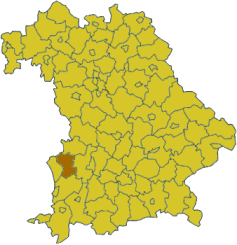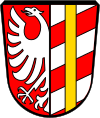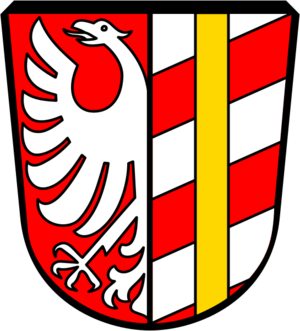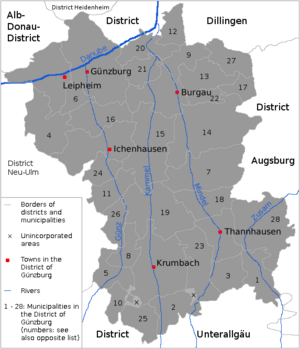Günzburg (district) facts for kids
Quick facts for kids
Günzburg
|
||
|---|---|---|
|
||
 |
||
| Country | ||
| State | Bavaria | |
| Adm. region | Swabia (Government Region) | |
| Region | Donau-Iller | |
| Capital | Günzburg | |
| Area | ||
| • Total | 763 km2 (295 sq mi) | |
| Population
(2000)
|
||
| • Total | 121,600 | |
| • Density | 159.37/km2 (412.8/sq mi) | |
| Time zone | UTC+1 (CET) | |
| • Summer (DST) | UTC+2 (CEST) | |
| Vehicle registration | GZ | |
| Website | landkreis-guenzburg.de (German) | |
The Günzburg district is a rural area in Swabia, a region in southwest Bavaria, Germany. It is a place where many people live and work. The main town and capital of the district is Günzburg.
This district shares its borders with several other districts. To the north, it neighbors Dillingen (district) and Heidenheim (district) (in Baden-Württemberg). To the east, you'll find Augsburg (district). To the south, it borders Unterallgäu and Alb-Donau (also in Baden-Württemberg). Finally, to the west, it is next to Neu-Ulm (district).
Contents
History and Symbols of Günzburg
Understanding the Coat of Arms
Every district has a special symbol called a coat of arms. It tells a story about the area's past. The coat of arms for Günzburg district shows two main parts.
On the right side, you see the old symbols of the margraviate of Burgau. This was a powerful area that was part of Austria. It ruled a large part of what is now the Günzburg district for many years, from 1305 until 1806.
On the left side, there is an eagle. This eagle comes from the symbols of the Schwabegg-Ursberg family. This important family helped start two monasteries in the district. Monasteries were places where monks lived and worked, often playing a big role in local life long ago.
Geography and Nature in Günzburg
The Günzburg district is known for its beautiful natural areas. Several rivers flow through the district, making the landscape green and fertile. These rivers start in the south and flow north towards the Danube River. The Danube is a very large river that runs along the northern edge of the district.
Rivers and Forests
Some of the rivers you'll find here include the Biber, Günz, Kammel, Mindel, and Zusam. Another river, the Nau, flows from the north into the Danube.
Between these rivers, there are hills. Many of these hills are covered with thick forests. These woods are home to many different plants and animals.
Augsburg Western Forests Nature Park
About one-third of the eastern part of the Günzburg district is part of a special protected area. This area is called the Augsburg Western Forests Nature Park. Nature parks help protect important landscapes and wildlife. They also offer places for people to enjoy nature, like hiking and exploring.
Towns and Communities in Günzburg
The Günzburg district is made up of several towns and many smaller communities. Each place has its own unique character and history.
Main Towns
Here are the main towns in the district:
- Burgau
- Günzburg
- Ichenhausen
- Krumbach
- Leipheim
- Thannhausen
Local Municipalities
And here are the many municipalities, which are smaller communities:
- Aichen
- Aletshausen
- Balzhausen
- Bibertal
- Breitenthal
- Bubesheim
- Burtenbach
- Deisenhausen
- Dürrlauingen
- Ebershausen
- Ellzee
- Gundremmingen
- Haldenwang
- Jettingen-Scheppach
- Kammeltal
- Kötz
- Landensberg
- Münsterhausen
- Neuburg an der Kammel
- Offingen
- Rettenbach
- Röfingen
- Ursberg
- Waldstetten
- Waltenhausen
- Wiesenbach
- Winterbach
- Ziemetshausen
See also
 In Spanish: Distrito de Gunzburgo para niños
In Spanish: Distrito de Gunzburgo para niños




